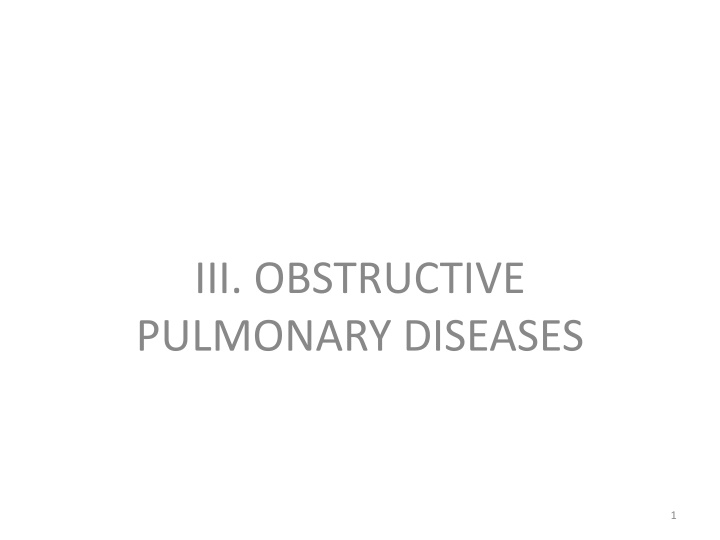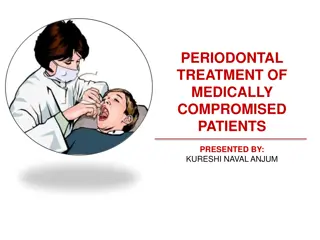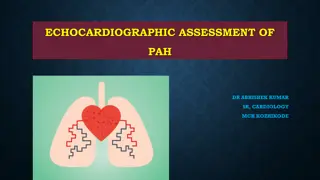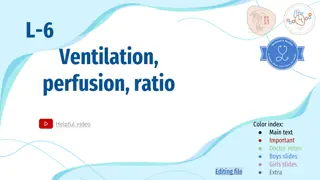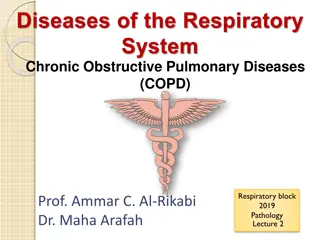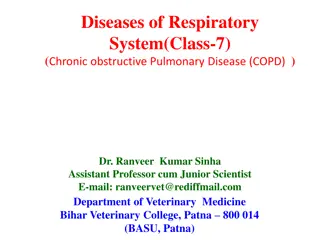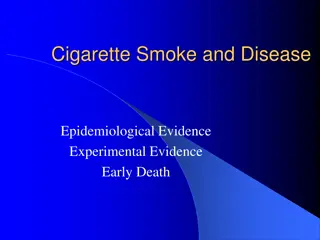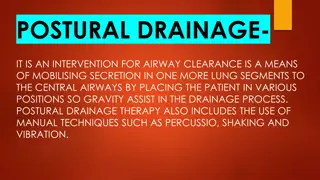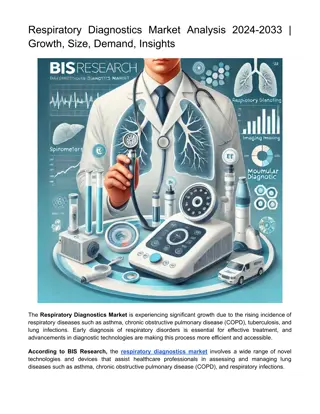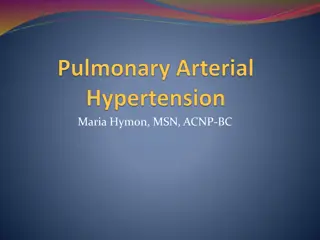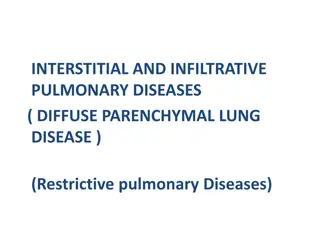Major Obstructive Pulmonary Diseases Overview
This content discusses major obstructive pulmonary diseases including emphysema, chronic bronchitis, bronchiectasis, and asthma. It covers their characteristics, causes, and distinctions. Emphysema is described as abnormal enlargement of air spaces without fibrosis, affecting the acinus. The overlap between these diseases and the common coexistence of emphysema and chronic bronchitis, clinically known as COPD, are also explored.
Download Presentation

Please find below an Image/Link to download the presentation.
The content on the website is provided AS IS for your information and personal use only. It may not be sold, licensed, or shared on other websites without obtaining consent from the author.If you encounter any issues during the download, it is possible that the publisher has removed the file from their server.
You are allowed to download the files provided on this website for personal or commercial use, subject to the condition that they are used lawfully. All files are the property of their respective owners.
The content on the website is provided AS IS for your information and personal use only. It may not be sold, licensed, or shared on other websites without obtaining consent from the author.
E N D
Presentation Transcript
Lecture 2 III. OBSTRUCTIVE PULMONARY DISEASES 1
The major diffuse obstructive disorders are 1. Emphysema, 2. Chronic bronchitis, 3. Bronchiectasis, 4. Asthma. 2
- Notes: 1- Expiratory obstruction may result either from A. Anatomic airway narrowing, such as in asthma, B. Loss of elastic recoil, characteristic of emphysema 3
2. Obstructive airway diseases have distinct clinical and anatomic characteristics but overlaps between emphysema, bronchitis, and asthma are common. 4
3. The definition of emphysema is morphologic, whereas chronic bronchitis is defined on the basis of clinical features 5
4. The anatomic distribution is different; chronic bronchitis initially involves the large airways, whereas emphysema affects the acinus. 6
5. Although chronic bronchitis may exist without emphysema, and pure emphysema may occur, the two diseases usually coexist - This is because the major cause- heavy tobacco exposure-is common to both disorders(Coexistent emphysema and chronic bronchitis is called clinically chronic obstructive pulmonary disease (COPD). . 7
Emphysema - Abnormal permanent enlargement of the air spaces distal to the terminal bronchioles accompanied by destruction of their walls without fibrosis with destruction of the alveolar septae and no fibrosis 8
Types of Emphysema Emphysema is classified according to its anatomic distribution within the lobule, the acinus is the structure distal to terminal bronchioles, and a cluster of three to five acini is called a lobule 10
Types of emphysema - There are four major types of emphysema: (1) Centriacinar, (2) Panacinar (3) Distal acinar, (4) Irregular. 11
1. Centriacinar (Centrilobular) Emphysema - The central or proximal parts of the acini, formed by respiratory bronchioles, are affected, while distal alveoli are spared - Both emphysematous and normal air spaces exist within the same acinus and lobule 12
- The lesions are more common and severe in the upper lobes. - This type of emphysema is most commonly caused by cigarrete smoking 14
PATHOGENESIS - Exposure to toxic substances such as tobacco smoke and inhaled pollutants induces ongoing inflammation with accumulation of neutrophils, macrophages and lymphocytes in the lung. - Neutrophils release elastases, cytokines (including IL-8) and oxidants causing epithelial injury and proteolysis of the extracellular matrix (ECM). - 15
2. Panacinar (Panlobular) Emphysema - The acini are uniformly enlarged, from the level of the respiratory bronchiole to the terminal blind alveoli - Tends to occur more commonly in the lower lung zones - It occurs in 1-antitrypsin deficiency. 16
3. Distal Acinar (Paraseptal) Emphysema - It involves the distal part of the acinus. - The proximal portion of the acinus is normal - Is more striking adjacent to the pleura, along the lobular connective tissue septa 17
- It occurs adjacent to areas of fibrosis - The characteristic finding is the presence of multiple, contiguous, enlarged air spaces ranging in diameter from less than 0.5 mm to more than 18
2.0 cm, sometimes forming cystic structures that, with progressive enlargement, are referred to as bullae - It is seen most often in cases of spontaneous pneumothorax in young adults. 19
4. Irregular Emphysema - The acinus is irregularly involved, - Is almost invariably associated with scarring, such as that resulting from healed inflammatory diseases. - Although clinically asymptomatic, this may be the most common form of emphysema. 20
PATHOGENESIS - Exposure to toxic substances such as tobacco smoke and inhaled pollutants induces ongoing inflammation with accumulation of neutrophils, macrophages and lymphocytes in the lung. - Neutrophils release elastases, cytokines (including IL-8) and oxidants causing epithelial injury and proteolysis of the extracellular matrix (ECM). - 21
- Unless checked by antielastases (e.g., 1- antitrypsin) and antioxidants, the cycle of inflammation and ECM proteolysis continues. - More than 80% of patients with congenital 1-antitrypsin deficiency develop symptomatic panacinar emphysema, which occurs at an earlier age and with greater severity if the affected person smokes . 22
- Multiple genetic factors control the response to injury after smoking. 1. For example, the TGFB gene exhibits polymorphisms that influence susceptibility to the development of COPD by regulating the response of mesenchymal cells to injury. 23
a- For example, with certain polymorphisms, mesenchymal cell response to TGF- signaling is reduced, which results in inadequate repair of elastin injury caused by inhaled toxins b- MMP-9 and MMP-12, have also been shown to have a pathogenic role in emphysema. 24
- MMP-9 gene polymorphisms and higher levels of both MMP-9 and MMP-12 have been found in some emphysema patients. - Moreover, MMP-12-deficient mice are protected from cigarette smoke-induced emphysema. 25
- In emphysema there is loss of not only epithelial and endothelial cells but also mesenchymal cells, leading to lack of extracellular matrix, the scaffolding upon which epithelial cells would have grown. 26
- Thus, emphysema can be thought of as resulting from insufficient wound repair. 27
MORPHOLOGY The diagnosis and classification of emphysema depend largely on the macroscopic appearance of the lung. 28
1. Panacinar emphysema, - Pale, voluminous lungs that obscure the heart 2. Centriacinar emphysema - The lungs are less voluminous - The upper two thirds of the lungs are more severely affected than the lower lungs. 29
Emphysema 30
Histologic examination reveals : a. Destruction of alveolar walls without fibrosis, leading to enlarged air spaces b. The number of alveolar capillaries is diminished. 32
- With the loss of elastic tissue in the surrounding alveolar septa, radial traction on the small airways is reduced. - As a result, they tend to collapse during expiration-an important cause of chronic airflow obstruction in severe emphysema. 33
Clinical Features - Dyspnea usually is the first symptom which begins insidiously but is steadily progressive. - Weight loss is common and may be so severe as to suggest a hidden malignant tumor. 34
- The classic presentation in emphysema with no "bronchitic" component is one in which the patient is a. Barrel-chested and dyspneic, b. with obviously prolonged expiration, c. Sitting forward in a hunched-over position, attempting to squeeze the air out of the lungs with each expiratory effort. 35
- Dyspnea and hyperventilation are prominent, so that until very late in the disease, gas exchange is adequate and blood gas values are relatively normal. - Because of prominent dyspnea and adequate oxygenation of hemoglobin, these patients sometimes are called "pink puffers." 36
